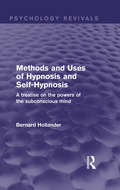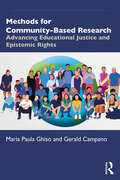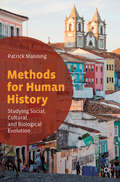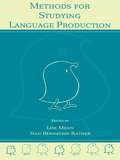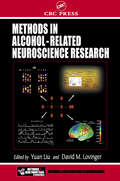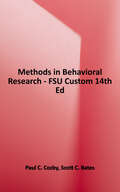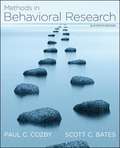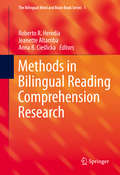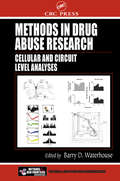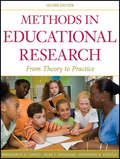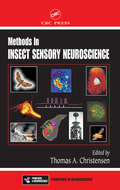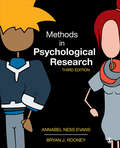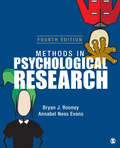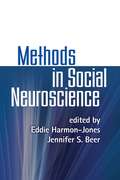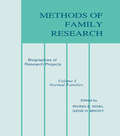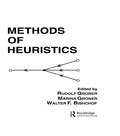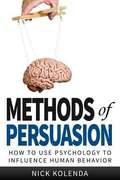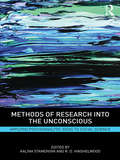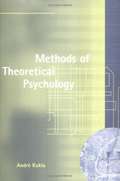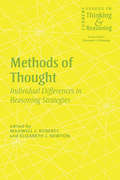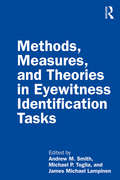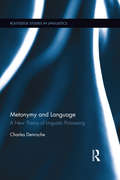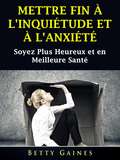- Table View
- List View
Methods and Uses of Hypnosis and Self-Hypnosis: A Treatise on the Powers of the Subconscious Mind (Psychology Revivals)
by Bernard HollanderOriginally published in 1928, the main object of this book was to draw attention to the importance of hypnotism and its phenomena, in order to stimulate inquiry into what was at the time a ‘mysterious and unexplored subject’. The author had studied hypnotism nearly all his life and practised it for thirty years, he therefore felt the investigations, experiences, and views presented in this title would prove of interest and value both to the medical and psychological expert and the general reader of the time. Today it can be read and enjoyed in its historical context.
Methods for Community-Based Research: Advancing Educational Justice and Epistemic Rights
by María Paula Ghiso Gerald CampanoMethods for Community-Based Research describes how Community-Based Research (CBR) is particularly suited to understand and take action on issues of educational justice.The book shifts assumptions about who is considered a researcher, drawing attention to issues of power and the ethics of collaborations, and foregrounding how those who have often been positioned as the objects of educational interventions can—and have the rights to—play an active role in creating educational arrangements more conducive to their own flourishing.The authors draw on a decade-long partnership across the boundaries of race, language, immigration status, and institutional affiliation to provide examples that illustrate the complexities and possibilities of this work. They distill principles, practices, and ongoing inquiries for researchers to consider across all aspects of the research process.The book supports researchers in creating the conditions for collaborative inquiry into issues of educational (in)justice that are salient to community partners. It will be of interest to advanced undergraduate, graduate students and scholars in education, and other disciplines that utilize a CBR method such as healthcare research and anthropology, as well as scholars interested in qualitative methods and issues of social justice in research.
Methods for Human History: Studying Social, Cultural, and Biological Evolution
by Patrick ManningThis book presents a concise yet comprehensive survey of methods used in the expanding studies of human evolution, paying particular attention to new work on social evolution. The first part of the book presents principal methods for the study of biological, cultural, and social evolution, plus migration, group behavior, institutions, politics, and environment. The second part provides a chronological and analytical account of the development of these methods from 1850 to the present, showing how multidisciplinary rose to link physical, biological, ecological, and social sciences. The work is especially relevant for readers in history and social sciences but will be of interest to readers in biological and ecological fields who are interested in exploring a wide range of evolutionary studies.
Methods for Studying Language Production
by Nan Bernstein Ratner Lise MennIn this volume, which simultaneously honors the career contributions of Jean Berko Gleason and provides an overview of a broad and increasingly important research area, a panel of highly productive language researchers share and evaluate methods of eliciting and analyzing language production across the life span and in varying populations. Chapters address a wide variety of historical and evolving approaches to data collection for the study of morphosyntax, the lexicon, and pragmatics, both laboratory-based and naturalistic. Special concerns that arise in the study of atypical child development, aging, and second language acquisition are a focus of the discussion.
Methods in Alcohol-Related Neuroscience Research (Frontiers in Neuroscience)
by David M. Lovinger Yuan LiuWritten by a panel of experts, Methods in Alcohol-Related Neuroscience Research not only provides information of a technical nature but also gives an overview of the many areas in investigating the effects of alcohol on the brain. It gives technical guidance for investigators doing research at the molecular, cellular, systems, and behavioral levels. These techniques include a wide variety of approaches, ranging from gene mapping and examination of molecular interactions of alcohol at the sub-cellular level to recording of neural activities in freely-behaving animals and imaging alcohol effects on the living human brain.
Methods in Behavioral Research
by Paul C. Cozby Scott C. BatesThis book guides students toward success by helping them study smarter and more efficiently. Supported by SmartBook®, McGraw-Hill Education's adaptive and personalized reading experience, Cozby and Bates provide helpful pedagogy, rich examples, and a clear voice in their approach to methodological decision making.
Methods in Behavioral Research (Eleventh Edition)
by Paul C. Cozby Scott C. BatesMethods in Behavioral Research has achieved its market-leading position with its concise and strategic approach to methodological decision making. Combining helpful pedagogy and rich examples, Cozby's eleventh edition again incorporates learning objectives, illustrative graphics, and activities to increase student involvement. Highlights of the new edition include a broader introduction of different research techniques in Chapter 4, extensive revision of the “validity of measurements̶ section, and updated structural equations models.
Methods in Behavioral Research (Thirteenth Edition)
by Bates CozbyMethods in Behavioral Research continues to guide students toward success by helping them study smarter and more efficiently. In tandem with SmartBook, McGraw-Hill Education’s adaptive and personalized reading experience, Cozby and Bates provide helpful pedagogy, rich examples, and a clear voice in their approach to methodological decision-making.
Methods in Bilingual Reading Comprehension Research
by Jeanette Altarriba Roberto R. Heredia Anna B. CieślickaThe collected essays in this volume present an overview and state-of-the-field of traditional and recently developed methodological approaches to the study of bilingual reading comprehension. It critically reviews and examines major findings from classical behavioral approaches such as the visual moving window, rapid-serial visual presentation (RSVP), and eye-tracking, as well as newly developing neuropsycholinguistic methodologies such as Event-Related Potentials (ERPS), and Functional Magnetic Resonance Imaging (fMRI). Written to address a timely topic, Methods in Bilingual Reading Comprehension Research updates the field of bilingual reading by critically examining the contributions of the various behavioral and technologically-based reading techniques used to understand psychological processes underlying written language comprehension. Each topic is covered first from a theoretical, and then from an experimental, viewpoint. Moreover, the volume contributes to the development and establishment of Bilingual Reading as a subfield of bilingual sentence processing and fills a significant gap in the literature on bilingual language processing and thought. Significantly, Methods in Bilingual Reading Comprehension Research presents an overall view of some of the typical psycholinguistic techniques and approaches, as well as proposing other possible tasks that may prove viable in investigating such theoretical issues as bilingual lexical ambiguity resolution, or how bilingual speakers might resolve multiple sources of potentially conflicting information as they comprehend sentences and discourse during the communicative process. In addition, to aid reader comprehension and encourage readers to acquire "hands on" experience in the creation and development of experiments in the realm of bilingual reading research, each chapter includes a list of key words, suggested student research projects, and questions to both help the reader review the chapter and expand upon the reading. With its comprehensive coverage of a crucial subfield of psycholinguistics and language processing, Methods in Bilingual Reading Comprehension Research is an invaluable and informative resource for all students and researchers in bilingualism, neurolinguistics, bilingual cognition, and other related fields.
Methods in Drug Abuse Research: Cellular and Circuit Level Analyses (Frontiers in Neuroscience)
by Barry D. WaterhouseThe field of drug addiction and substance abuse, which was initially confined to behavioral studies, has broadened dramatically. It now includes a vast array of cellular and molecular approaches as well as sophisticated electrophysiological and neurochemical methodologies that bridge the gap between cellular/molecular events and behavior. In many c
Methods in Educational Research
by Dean T. Spaulding Katherine H. Voegtle Marguerite G. LodicoMethods in Educational ResearchMethods in Educational Research is designed to prepare students for the real world of educational research. It focuses on scientifically-based methods, school accountability, and the professional demands of the twenty-first century, empowering researchers to take an active role in conducting research in their classrooms, districts, and the greater educational community. Like the first edition, this edition helps students, educators, and researchers develop a broad and deep understanding of research methodologies. It includes substantial new content on the impact of No Child Left Behind legislation, school reform, quantitative and qualitative methodologies, logic modeling, action research, and other areas. Special features to assist the teaching and learning processes include vignettes illustrating research tied to practice, suggested readings at the end of each chapter, and discussion questions to reinforce chapter content.Praise for the Previous Edition"A new attempt to make this subject more relevant and appealing to students. Most striking is how useful this book is because it is really grounded in educational research. It is very well written and quite relevant for educational researchers or for the student hoping to become one." -PsycCRITIQUES/American Psychological Association"I applaud the authors for their attempt to cover a wide range of material. The straightforward language of the book helps make the material understandable for readers." -Journal of MultiDisciplinary Evaluation
Methods in Insect Sensory Neuroscience
by Thomas A. ChristensenInsects are among the most diverse and adaptable organisms on Earth. They have long been our chief competitors for food and are responsible for spreading devastating afflictions such as malaria and encephalitis. The insects' ability to thrive is due in large part to their well-developed sensory systems, which present a host of novel physiological,
Methods in Psychological Research
by Annabel Ness Evans Bryan J. RooneyThis interactive and highly applied text engages students with a rich mix of pedagogy (including unique FAQs and FYIs), a casual reader-friendly writing style, and examples of real psychological research from both research literature and student research projects. In this updated third edition of Methods in Psychological Research, authors Annabel Ness Evans and Bryan J. Rooney focus on applying concepts and doing research with simple in-text exercises. Friendly and supportive in tone, this unique presentation of the basics conveys to students the excitement and fun of the research enterprise.
Methods in Psychological Research
by Annabel Ness Evans Bryan J. RooneyMethods in Psychological Research introduces students to the rich world of research in psychology through student-friendly writing, compelling real-world examples, and frequent opportunities for practice. Using a relaxed yet supportive tone that eases student anxiety, the authors present a mixture of conceptual and practical discussions, and spark reader interest in research by covering meaningful topics that resonate with today’s students. In-text features like Conceptual Exercises, FYI sections, and FAQ sections with accompanying visual cues support learning throughout the research experience. The Fourth Edition equips students with the tools they need to understand research concepts, conduct their own experiments, and present their findings.
Methods in Psychological Research
by Annabel Ness Evans Bryan J. RooneyMethods in Psychological Research introduces students to the rich world of research in psychology through student-friendly writing, compelling real-world examples, and frequent opportunities for practice. Using a relaxed yet supportive tone that eases student anxiety, the authors present a mixture of conceptual and practical discussions, and spark reader interest in research by covering meaningful topics that resonate with today’s students. In-text features like Conceptual Exercises, FYI sections, and FAQ sections with accompanying visual cues support learning throughout the research experience. The Fourth Edition equips students with the tools they need to understand research concepts, conduct their own experiments, and present their findings.
Methods in Social Neuroscience
by Jennifer S. Beer Eddie Harmon-JonesStraightforward and practical, this is the first book to provide detailed guidance for using neurobiological methods in the study of human social behavior, personality, and affect. Each chapter clearly introduces the method at hand, provides examples of the method's applications, discusses its strengths and limitations, and reviews concrete experimental design considerations. Written by acknowledged experts, chapters cover neuroimaging techniques, genetic measurement, hormonal methods, lesion studies, startle eyeblink responses, facial electromyography, autonomic nervous system responses, and modeling based on neural networks.
Methods of Family Research: Biographies of Research Projects
by Irving E. Sigel Gene H. BrodyThese companion volumes provide a "behind the scenes" look into the personal experiences of researchers in an effort to eliminate the lack of communication surrounding family research methodology. They show how the researchers achieved their results and why they chose particular methodologies over others. These volumes present more than just findings -- they present the real experiences of the authors in their own styles and personalities, exposing the problems, mistakes, and concerns they experienced during their research projects. Volume I presents the experiences of researchers into typical normative populations. Volume II describes work with clinical, atypical populations.
Methods of Heuristics
by Walter F. Bischof Rudolf Groner Marina GronerThis volume constitutes the edited proceedings of an interdisciplinary symposium on Methods of Heuristics, which was held at the University of Bern, Switzerland, from September 15 to 19, 1980. In organizing the symposium, the editors of the present volume were able to invite specialists from psychology, computer science, and mathematics. From their own perspective they made contributions to the central questions of the conference: What are heuristics, the methods and rules guiding discovery and problem solving in a variety of different fields? How did they develop in individual human beings and in the history of science? Is it possible to arrive at a commonly accepted definition of heuristics as the field unifying all these efforts, and, if yes, what are its basic characteristics?
Methods of Persuasion: How to Use Psychology to Control Human Behavior
by Nick KolendaUsing principles from cognitive psychology, Nick Kolenda developed a unique way to subconsciously influence people's thoughts. He developed a "mind reading" stage show depicting that phenomenon, and his demonstrations have been seen by over a million people across the globe. Methods of Persuasion reveals that secret for the first time. You'll learn how to use those principles to influence people's thoughts in your own life. Drawing from academic research in psychology, the entire book culminates a powerful 7-step persuasion process that follows the acronym, METHODS: Step 1: Mold Their Perception Step 2: Elicit Congruent Attitudes Step 3: Trigger Social Pressure Step 4: Habituate Your Message Step 5: Optimize Your Message Step 6: Drive Their Momentum Step 7: Sustain Their Compliance This book teaches you the psychology behind each step. You'll learn how to apply METHODS to your own life so that you can influence people's thoughts, emotions, and behavior in nearly any situation.
Methods of Research into the Unconscious: Applying Psychoanalytic Ideas to Social Science
by R. D. Hinshelwood Kalina StamenovaThe psychoanalytic unconscious is a slippery set of phenomena to pin down. There is not an accepted standard form of research, outside of the clinical practice of psychoanalysis. In this book a number of non-clinical methods for collecting data and analysing it are described. It represents the current situation on the way to an established methodology. The book provides a survey of methods in contemporary use and development. As well as the introductory survey, chapters have been written by researchers who have pioneered recent and effective methods and have extensive experience of those methods. It will serve as a gallery of illustrations from which to make the appropriate choice for a future research project. Methods of Research into the Unconscious: Applying Psychoanalytic Ideas to Social Science will be of great use for those aiming to start projects in the general area of psychoanalytic studies and for those in the human/social sciences who wish to include the unconscious as well as conscious functioning of their subjects.
Methods of Theoretical Psychology
by André KuklaTheoretical psychology stands in the same relation to psychology as theoretical physics does to physics. The traditional way to study theoretical psychology is to take up one approach after another--behavioral, psychoanalytic, cognitive, and so on.
Methods of Thought: Individual Differences in Reasoning Strategies (Current Issues in Thinking and Reasoning)
by Maxwell J. Roberts Elizabeth J. NewtonHow do people make inferences? How do their reasoning processes differ and why? Methods of Thought attempts to answer these questions by looking in detail at the different reasoning strategies people apply, how these are acquired, how they are selected and how use of these strategies is influenced by individual and task properties. Focusing on empirical data and research into deductive reasoning tasks, this book summarizes current trends in the field and helps us to understand how individual differences in reasoning impact on other studies of higher cognitive abilities in humans. Contributors include researchers who have shown that people make deductions by using a variety of strategies, and others who have found that deductive reasoning problems provide a useful test-bed for investigating general theories of strategy development. Together, it is shown that these general theories derived from other domains have important implications for deductive reasoning, and also that findings by reasoning researchers have wider consequences for general theories of strategy development. This book will be of interest to anyone studying or working in the fields of reasoning, problem solving, and cognitive development, as well as cognitive science in general.
Methods, Measures, and Theories in Eyewitness Identification Tasks
by Andrew M. Smith Michael P. Toglia James Michael LampinenMethods, Measures, and Theories in Eyewitness Recognition Tasks provides a comprehensive review of the fundamental issues surrounding eyewitness recognition phenomena alongside suggestions for developing a more methodologically rigorous eyewitness science. Over the past 40 years, the field of eyewitness science has seen substantial advancement in eyewitness identification procedures, yet theoretical and methodological developments have fallen behind. Featuring contributions from prominent international scholars, this book examines methodological and theoretical limitations and explores important topics, including how to increase the accuracy of identifying perpetrators when using CCTV images, how to create more identifiable facial composites, and the differences in accuracy between younger and older eyewitnesses. Providing in-depth discussion on the limitations of traditional lineups, eyewitness memory fallibility, and the complications that arise when using laboratory simulations, along with suggestions for new methods, this book will be an invaluable resource for researchers in eyewitness recognition, lawyers, players in the criminal justice system, members of innocence commissions, and researchers with interests in cognitive psychology.
Metonymy and Language: A New Theory of Linguistic Processing (Routledge Studies in Linguistics)
by Charles DenrocheMetonymy and Language presents a new theory of language and communication in which the central focus is on the concept of metonymy, the recognition of partial matches and overlaps. Through the use of original data sets and rigorous primary research, Denroche characterizes metonymy as key to understanding why language is so ‘fit for purpose’ and how it achieves such great subtlety and flexibility. This study develops the notion of ‘metonymic competence’ and demonstrates that metonymic behavior is often pursued for its own sake in recreational activities, such as quizzes, puzzles and play, and shows the possible impact of the application of metonymic processing theory to professional fields, such as language teaching and translator training. Furthermore, it proposes a research approach with metonymy at its center, ‘metonymics,’ which Denroche suggests could provide a powerful framework for addressing issues in numerous fields of practice in the arts and sciences.
Mettre Fin à L'inquiétude et à L'anxiété: Soyez Plus Heureux et en Meilleure Santé
by Betty GainesUn guide détaillé pour comprendre et éliminer les attaques de peur, de dépression, de panique et d'anxiété. Ce guide vous aidera à gérer et à éliminer votre anxiété. Il vous guidera également à travers les meilleures pratiques pour les surmonter. L'utilisation de médicaments pour lutter contre ces problèmes entraîne de nombreux effets secondaires désagréables et n'est pas recommandée, car ces problémes peuvent être surmontés naturellement. C'est pourquoi ce guide se concentre sur tous les méthodes naturels afin de vous donner les meilleurs résultats sans effets secondaires. Basé sur des données scientifiques solides et éprouvées, ce livre vous apprendra comment: - fair un stop à la panique - Arrêter le stress et l'anxiété - Utiliser des méthodes naturelles pour soulager l'inquiétude, la peur, la dépression et l'anxiété - Mieux dormir - Se sentir en meilleure santé et avoir plus d'énergie pour profiter de la vie - Penser plus clairement - Vivre la vie que vous méritez Si vous voulez être a votre meilleur avec peu ou pas d'inquiétude, de peur, et d'anxiété , alors ce livre est pour vous. -> Faites défiler vers le haut de la page et cliquez sur Ajouter au panier pour acheter instantanément
